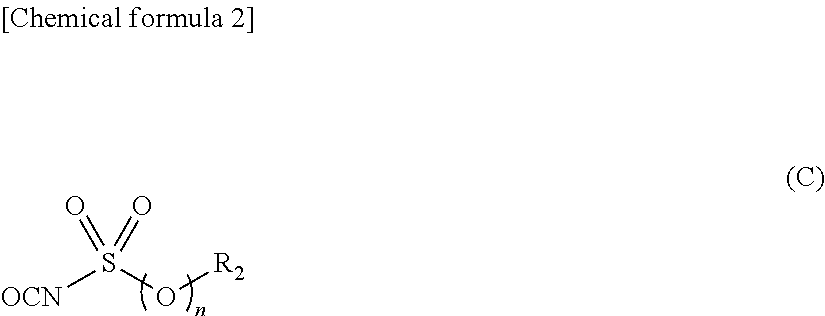Nonaqueous electrolyte solution and nonaqueous electrolyte battery using same
a technology of nonaqueous electrolyte and electrolyte, which is applied in the direction of negative electrodes, cell components, electrochemical generators, etc., can solve the problems of lowering the charge/discharge capacity, and achieve the effect of reducing the expansion of the battery, and excellent general performan
- Summary
- Abstract
- Description
- Claims
- Application Information
AI Technical Summary
Benefits of technology
Problems solved by technology
Method used
Image
Examples
examples
[0462]Hereinbelow, the present invention will be described in more detail with reference to the following Examples and Comparative Examples, which should not be construed as limiting the scope of the present invention.
[0463]The abbreviations for the compounds used in the present Examples are shown below.
[0464]Lithium fluorosulfonate; FSLi
[0465]Lithium difluorophosphate; DFPLi
[0466]Hexamethylene diisocyanate; HMDI
[0467]1,3-Bis(isocyanatomethyl)cyclohexane; BIMCH
[0468]Lithium bis(fluorosulfonyl)imide; LiFSI
[0469]p-Toluenesulfonyl isocyanate; TSI
[0470]Diisocyanatosulfone; DIS
[0471]Fluorosulfonylmethane; FSO2Me
[0472]Ethyl isocyanate; EtNCO
[0473]Isopropyl isocyanate; iso-PrNCO
[0474]tert-Butyl isocyanate; tert-BuNCO
[0475]Methyl fluorosulfonate; FSO3Me
[0476]Benzenesulfonyl fluoride; FSO2Ph
[0477]Benzylsulfonyl fluoride; FSO2CH2Ph
[0478]1,3-Propane sultone: PS
[0479]Maleic anhydride: MAL
[0480]Vinylene carbonate: VC
[0481]Vinylethylene carbonate: VEC
examples 1-1 to 1-7
and Comparative Example 1-1
Preparation of a Positive Electrode
[0482]85% by mass of lithium-nickel-cobalt-manganese compound oxide (NMC) as a positive electrode active material, 10% by mass of acetylene black as a conductive material, and 5% by mass of polyvinylidene fluoride (PVdF) as a binder were mixed in an N-methylpyrrolidone solvent using a disperser to form a slurry. The slurry was uniformly applied to both surfaces of an aluminum foil having a thickness of 21 μm, and dried and then pressed to obtain a positive electrode.
[0483][Preparation of a Negative Electrode]
[0484]50 g of Si fine particles having an average particle diameter of 0.2 μm were dispersed in 2,000 g of flaky graphite having an average particle diameter of 35 μm, and the resultant mixture was placed in a hybridization system (manufactured by Nara Machinery Co., Ltd.), and circulated or retained in the apparatus at a rotor rotational speed of 7,000 rpm for 180 seconds to effect a treatment, obtaining a composite ...
examples 2-1 to 2-14
and Comparative Example 2-1
Preparation of a Positive Electrode and a Negative Electrode
[0516]The positive electrode and negative electrode active materials prepared in Example 1 were used.
[0517][Preparation of a Nonaqueous Electrolyte Solution]
[0518]Under a dry argon atmosphere, satisfactorily dried LiPF6 was dissolved in a mixture of EC and DEC (volume ratio: 3:7) at 1.0 mol / L (in terms of a concentration in the nonaqueous electrolyte solution), and further vinylene carbonate (VC) and fluoroethylene carbonate each in an amount of 2.0% by mass were added thereto (the resultant solution is referred to as “reference electrolyte solution 2”). Compounds were individually added in their respective proportions shown in Table 4 below to the entire reference electrolyte solution 2 to prepare electrolyte solutions. Comparative Example 2-1 corresponds to reference electrolyte solution 2 per se.
[0519]
[0520][High-Temperature Cycle Test]
[0521]In a thermostatic chamber at 25° C., with respect to ...
PUM
 Login to View More
Login to View More Abstract
Description
Claims
Application Information
 Login to View More
Login to View More - R&D
- Intellectual Property
- Life Sciences
- Materials
- Tech Scout
- Unparalleled Data Quality
- Higher Quality Content
- 60% Fewer Hallucinations
Browse by: Latest US Patents, China's latest patents, Technical Efficacy Thesaurus, Application Domain, Technology Topic, Popular Technical Reports.
© 2025 PatSnap. All rights reserved.Legal|Privacy policy|Modern Slavery Act Transparency Statement|Sitemap|About US| Contact US: help@patsnap.com



